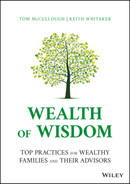SECTION 8
MAKING SHARED DECISIONS
One of the most challenging aspects of managing financial wealth together as a family is making shared decisions. All families make decisions. But the ways they make decisions are often left unspoken and unexamined. Perhaps there is one “true” decision-maker, the wealth creator or the eldest family member. Maybe whoever “pushes” the most drives the decision.
For families to succeed over time, they need to make, on balance, more good decisions than bad ones; they also need to decide how to decide—that is, in a clear and intentional way, think through how to make various decisions, decide what works best for them in which circumstances, and then communicate those decisions clearly. This work is sometimes called family “governance.”
The chapters in this section explore different aspects of governance. In the first chapter, Lee Hausner offers an exercise that helps families visualize their existing structure of decision-making. Through asking family members at a family gathering to don different hats based on their roles in the family—parent, child, trustee, beneficiary, business owner, manager, etc.—a family can quickly see where authority for different decisions resides. They can also begin to discuss what information and communication are needed to make effective decisions. To top it off, it's a very fun exercise too.
Jim Grubman then offers a framework (first published in the first Wealth of Wisdom volume) for making wise decisions about different practices in the family. He asks readers to reflect on what family traditions, habits, practices, or ideas family members find helpful and want to preserve; which seem vestiges from the past and are no longer contributing to the family's well-being; and what new practices or ideas the family could adopt that would help them adapt to the future. This backward-and-forward gaze honors the reality that every family is in the midst of a journey from the past into the future.
In the next chapter, Stacy Allred moves the focus from the big picture to more specific decisions, such as sharing information about wealth with an adult child or making a loan to a friend. She invites readers to analyze such decisions using, first, a “premortem”—in which one envisions all the things that could go wrong, and so identifies risks—and then, second, a “promortem”—in which one envisions what steps could be taken to ensure a successful outcome.
As mentioned, in many families, decisions are made by one or two family members, usually parents. This paternalistic approach can lead to problems as children mature and grow into adults themselves. In the next chapter, Barbara Hauser uses insights from the governance of nations to highlight three principles that are key also to family governance: transparency, accountability, and participation. If these three principles are honored in a family's decision-making, the results are often more understood, more effective, and more long-lasting.
An extension of these principles comes in the next chapter, in which Kathryn McCarthy offers the “RACI” (pronounced RAY-SEE) framework to apply to decision-making in a complex family enterprise. This framework works best in a system where there are multiple boards or entities governing different parts of the family's affairs (such as an operating company board, management, foundation board, trustees, etc.). RACI distinguishes among people who are Responsible, those who are Accountable, those who should be Consulted, and those who need to be Informed. McCarthy offers the example of a matrix in which a family enterprise can keep track of these different categories for different stakeholders. This is advanced decision-making, but for families with this level of complexity, it can be extremely useful.
One form of a family enterprise is a family office—whether a stand-alone “single family office” or a family office embedded within a family-owned operating company—which handles all the family's financial affairs. In the next chapter, Eugene Lipitz takes up the important subject of developing internal controls and transparent workflows for the critical tasks of the family office. Development of such controls may sometimes feel too “formal” for an entity which is, after all, about the family—yet doing so can save a great deal of family confusion or conflict but also can guard against fraud or poorly informed decision-making.
One of the most valuable practices for families who are managing significant financial wealth or other assets together is to hold regular family meetings. These meetings can be for the purpose of educating family members about the finances, connecting with each other and having fun, or making shared decisions. Whatever the specific purposes, developing the habit of holding effective family meetings is a clear success factor for enterprising families.
That's why we devote the last two chapters in this section to family meetings. In the first, Katherine Grady and Wendy Ulaszek lay out practical, step-by-step considerations for families who want to hold a productive family meeting. They move from the question of why meet, to who should be invited, to how to assemble the agenda in line with the meeting goals, to the crucial considerations of where to meet, for how long, with whose direction, etc. Even for families who have a tradition of meeting, this chapter will provide insights into enhancing meeting design and execution.
In the final chapter, Keith Whitaker focuses in on one aspect of family meeting management: the articulation of meeting ground rules. Ground rules may feel awkward for a family meeting: We're family, after all! But experience shows that agreeing upon such rules at the beginning of a family meeting process can be invaluable for giving participants a sense that the meeting will be a safe place to discuss important topics, topics that sometimes come with strong emotional content. Sometimes in the heat of discussion, family members will break the rules, but then the group will be able to refer back to the rules and reaffirm the family's norms. And over time the ground rules become just “the way we treat each other.” Deciding on meeting ground rules is one of the most important shared decisions a family can make.
